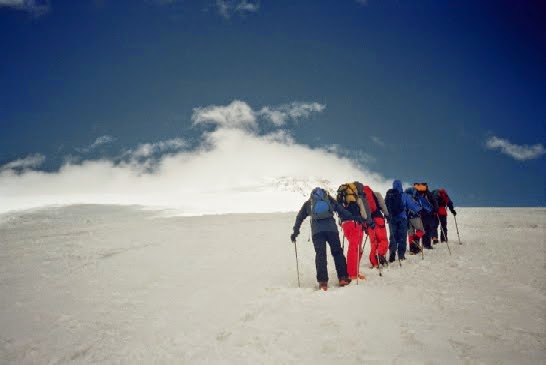 |
| One of my worse AMS experience was on this mountain. Mt Elbrus, Caucasus 2004. slow-going, acclimatization climb. |
Before you read this post, read previous article about
Acclimatization.
So, you've got AMS. Don’t
panic, there’s hope. =)
If one is experiencing severe AMS (with edema), the only
sure cure is to go down the mountain! Evacuate ASAP! If unable to evacuate, and if
you’re lucky to have a gamow bag (portable chamber) and/or O2 bottles – then
this may be life-saving tools. Use gamow
bag with big caution - make one mistake (like sudden release of pressure) and
you could kill someone inside.
This article below is more focused on mild AMS
(characterized by headache, nausea, occasional vomiting, lack of appetite,
etc.), how to prevent it from progressing to a severe form, or how to fix;
1.
Rest and avoid gaining more (sleeping) altitude. It means, if you’re sick now, further
walking up (to thinner air) to sleep or camp will worsen your AMS.
2.
If you feel that you’re getting worse (consult
your guide or team mate) – consider the option of reducing your altitude by at
least 1000ft. The lower the better (the
thicker the air) but of course, more effort if you will go up again.
3.
Hydrate!
3li or more. Just mind your electrolytes
when over-hydrating (ensure you don’t significantly wash down all your
potassium, sodium, sugar) – over-drinking purified or distilled water may cause
big problems. Best to mix water with
juice, or drink other liquids like soup.
4.
With lack of appetite, if would be a challenge
to re-energize with food. I’ve tried
(and witnessed AMSd teammates) to consume fruits and was able to. And try to gulp soups. Egg drop version would be easiest (and loaded
with protein). In my bad AMS days, I was
only able to eat noodle meals with lots of garlic.
5.
Do breathing exercise. Inhale more air (get more O2 from thin air),
followed by short exhale (it’s hard to hold breath at altitude). At night, elevate your head (more pillows) to
help with your breathing.
6.
Since moving about is difficult (but highly
recommended), plan your movement. Ex.
step1, get tissue from my bag, step2- go to toilet, step3- get my water bottle for refill, step4-
go to kitchen for refill. Trust me, with
hypoxic hypoxia (lack of O2) – even simple, outlined tasks can be missed. And as a consequence, tiring. Imagine going to the bathroom 100 meters
away, only to realize you forgot your tissue wipes. Easy to do while in the low urban setting,
but at altitudes, when your resting heart rate (BPM) is doing 105+, performing
very simple tasks shoots that up to 120 or more– it could be physically and
emotionally challenging!
7.
Take meds if you have to. Headache? Take your tested meds (paracetamol
or ibuprofen, etc.). just ensure your meds are ‘compatible’ with your other
meds or your condition. Some take diamox
(believed to reduce AMS), which somehow failed to cure mine.
8.
If you can, or force yourself to – do a ‘climb
high sleep low’ routine. Even just a
hundred meters of elevation may bring magic.
Just go out, grab your cam, walk very slowly and deliberately
(presumably during rest day), gain some altitude, stay for a little while (1hr or more if you
can), BUT walk down to sleep at lower elevation.
9.
If you are alone and experiencing bad AMS for
the first time - that might be the worse
days of your trekking life. My advise -
best to have a team, a buddy, or a guide who can physically or emotionally
nurse you back to your trekking life.
There will be days in the mountain when one feels that all his/her strength and confidence has faded or fading away. Realize that AMS may sap all these energies and mental strength. Just live thru it, fix yourself, and climb on!
No comments:
Post a Comment